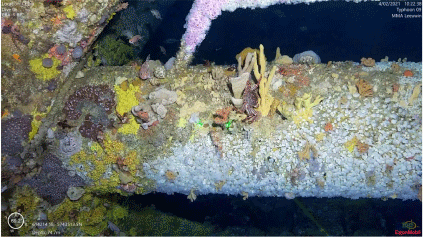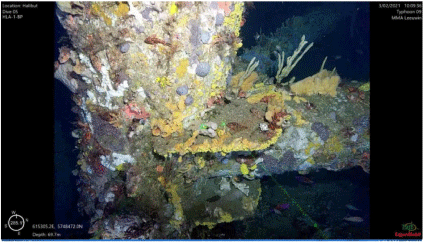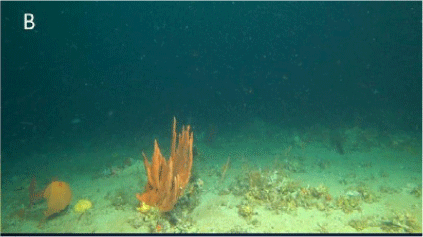Environmental benefits of leaving steel-piled jacket platforms in place
Sheela Veluayitham A * , Louise Mayboehm A and Katie Martin AA Esso Australia Pty Ltd, Melbourne, Vic., Australia.
Abstract
With many of the Bass Strait reservoirs having reached the end of their productive life, Esso has been planning and preparing for the decommissioning of facilities including the currently non-producing steel-piled jacket platforms (platforms). Given many of these platforms have been in place for several decades, it is important to understand the ecosystem that has established around them to ensure that the environmental impacts and risks of decommissioning are appropriately assessed. Esso undertook an offshore environmental survey in 2021 using a remotely operated vehicle (ROV) to collect visual imagery of the environment around a representative set of platforms (and pipelines), including reference sites (natural seabed environment), to supplement available literature with site-specific data. The Australian Institute of Marine Science (AIMS) performed detailed analysis of the fish and benthic communities that are associating with the infrastructure to provide insights into understanding the habitat value of the infrastructure. An equal or better environmental outcome assessment undertaken by Esso identified that preserving the marine communities that have established on and around the platforms is a key consideration between complete removal of platforms and the proposed end state of retaining the lower sections (minimum 55 m below mean sea level) of selected platforms in situ.
Keywords: decommissioning, environmental benefits, equal or better environmental outcome, habitat value, impacts, preserving, risks, steel-piled jacket platforms.
Introduction
Esso Australia Resources Pty Ltd (Esso) is the operator of joint ventures for the exploration, development and production of oil and gas from Bass Strait, Victoria. The offshore Bass Strait production network is comprised of 421 wells, 19 offshore platforms and five subsea facilities that are inter-connected by over 800 km of pipelines. After delivering energy to Australia for over 50 years, many of the Bass Strait reservoirs are now reaching the end of their productive life and Esso has been planning and preparing for the decommissioning of facilities including the currently non-producing steel-piled jacket platforms (platforms).
Given many of the platforms have been in place for several decades, it is important for Esso to understand the ecosystem that has established around the platforms to ensure that the environmental benefits, impacts and risks of decommissioning options are assessed. To increase knowledge of the habitat value of the platforms, Esso undertook an environmental survey in 2021 of the marine habitats around the infrastructure. A further environmental survey was conducted in 2022 to assess for any seasonal or temporal variations. Analysis of the 2022 survey data is in progress at the time of writing.
Detailed survey of marine communities to assess the habitat value of platforms
The survey used an underwater remotely operated vehicle (ROV) to collect high-definition imagery of benthic and fish communities around a representative set of platforms including reference locations (natural seabed environment) to supplement available literature with site-specific data. The platforms surveyed were specifically selected to cover a range of water depths, structural characteristics, age, proximity to other structures and geographic spread across the production area.
The survey utilised a dual camera system to collect imagery to identify and characterise marine growth, fish communities and benthic habitats. The ROV transects captured the marine communities on each face of the surveyed platforms across the full depth of the water column. The Australian Institute of Marine Science (AIMS) performed detailed analysis of the fish and benthic communities associated with the infrastructure to provide an increased understanding of the ecosystem/s (McLean et al. 2022).
Observations of the marine environment around the platforms
Natural surrounding ecosystems were dominated by sand, mud and gravel (>95%) substratum, with limited and patchy distribution of benthic biota (primarily sponges) (McLean et al. 2022). Notably, platforms had a very high density of biota and were far more complex in terms of three-dimensional epibenthic structure than those that were observed in the benthic surrounds, at reference sites and at the South East Reef (McLean et al. 2022).
The dominant sessile biota observed on all platforms surveyed were cnidarians, primarily jewel anemone (Corynactis australis), occurring across most depths of the platforms except where closest to the seabed (lowest 10 m sections of the platform structure). The dominance of the jewel anemone suggests that it is capable of excluding other species which can lead to a low benthic diversity but could also limit the establishment of invasive species (McLean et al. 2022).
The jewel anemone exhibited notable colour variations among the jacket platforms and with depth from the surface to seabed, a phenomenon not previously observed. Jewel anemones are not known to occur at other offshore reef environments in this region, with reports of occurrence typically associated with inshore rocky reefs and artificial structures such as jetties.
Sponges were the next dominant benthic biota observed near lower platform sections, where they exhibited a range of morphologies and were the most dense (McLean et al. 2022). The sponges observed growing on the platforms may contain a different suite of species compared to natural habitats as they appeared to be morphologically distinct (McLean et al. 2022). The platforms are providing an artificial habitat which is spanning the water column, and subsequently supporting a diversity of functionally distinct sponge assemblages including crusts, massive and erect forms (McLean et al. 2022).
The fish assemblages recorded in the 2021 survey comprised a total of 123 852 individual fishes from 69 taxa spanning 41 families. The most abundant fishes observed in the survey tended to be small schooling species such as scad (Trachurus spp.), butterfly perch (Caesioperca lepidoptera) and Australian anchovy (Engraulis australis) (McLean et al. 2022). Fish assemblages observed on platforms were markedly different to those in surrounding natural ecosystems of the Bass Strait, with many reef-associated and schooling species observed on platforms and sand-affiliated species in natural ecosystems (McLean et al. 2022). A higher abundance of fish species was observed at all the platforms compared to the natural reef and reference sites.
The Australian fur seal (Artocephalus pusillus doriferus), a protected species under the Environment Protection and Biodiversity Conservation Act (resulting from significantly reduced populations due to historical sealing practices), was observed a number of times in the footage collected around the platforms. Fur seals are frequently observed by the offshore platform operators to be aggregating and hauling-out on the platform structures. Fish species noted in large numbers around the platforms and targeted as prey by the Australian fur seals include the scad, reef ocean perch, butterfly perch and Scorpaeniformes species (McLean et al. 2022). The platforms probably provide haul-out opportunity for seals which allows them to increase their feeding range from their normal colony (coastal islands of Victoria and Tasmania).
The imagery collected confirmed that the platforms are providing hard substrate habitat which is supporting thriving communities rich in species diversity and abundance in comparison to surrounding reference sites (Figs 1–3). No other natural habitat features span the water column in this region, and it is therefore clear that the platform structures provide novel habitat that is supporting benthic and fish communities that differ to those present in the predominantly sand/mud and gravel ecosystems surrounding them (McLean et al. 2022).
Decommissioning options assessment: equal or better environmental outcome (EOBO)
The National Offshore Petroleum Safety and Environmental Management Authority’s (NOPSEMA) policy Section 572 Maintenance and Removal of Property requires that an Environment Plan seeking a deviation from the Offshore Petroleum Greenhouse Gas Storage Act 2006 (Cth) Section 572(3) requirement for removal of all property, when no longer in use, must include:
A feasibility assessment of all decommissioning options that could reasonably be undertaken and are likely to be successful.
An evaluation of the environmental impacts and risks of all feasible options to enable NOPSEMA to have regard to the Australian Government Decommissioning Guideline policy principle that deviations will provide an EOBO when compared to complete removal.
Esso firstly undertook a feasibility screening assessment of potential decommissioning options for the platforms including partial and complete removal options. The environmental impacts and risks of the options assessed as ‘feasible’ were evaluated and assessed to determine if the option would provide an ‘EOBO’ when compared to complete removal.
The preservation of the established (‘novel’) ecosystems on and around the platforms was assessed as the key consideration resulting in an EOBO, when comparing complete removal (which would revert the seabed to a state reflective of the likely pre-installation seabed state (sand-dominated) similar to the reference sites) with retaining the lower sections of selected platforms in situ (minimum 55 m below mean sea level).
The survey demonstrated that the biological communities associated with the platforms more closely resemble elements of near-shore reef communities than those observed at the reference sites. Analysis of the footage showed that the platforms surveyed are providing habitat for diverse fish communities. In general, fish assemblages observed on the platforms surveyed are unique for this offshore region of the Bass Strait and likely play an important role in the functioning of food webs in the area with representation of diverse trophic levels (McLean et al. 2022).
While partial removal of the platforms (minimum 55 m below mean sea level) will result in the loss of sessile biota on the upper sections of the platforms removed, remaining structure would provide hard substrate, which is critical for the species established in this region. Species richness and abundance was noted to be highest in the deepest sections of the surveyed platforms. Sections of retained platforms (minimum 55 m below mean sea level) which have been in place for many decades (in some instances over 50 years) would provide ongoing ecological service through provision of habitat and foraging opportunities.
Conclusion
It is evident from the offshore survey that the platforms, being the dominant hard substrate in an area which is predominantly sandy environment, are supporting a diverse (‘novel’) ecosystem. The natural surrounding areas (reference sites) were dominated by sand, mud and gravel with limited and patchy distribution of benthic biota (primarily sponges) which was markedly different to the platforms which had a higher abundance of sessile (benthic) biota and fishes. Preserving the marine communities that have established on and around the platforms would provide ongoing ecological service through provision of habitat and foraging opportunities.





